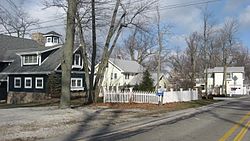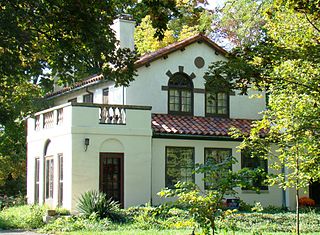
The Reeveston Place Historic District is a neighborhood of homes and national historic district located at Richmond, Wayne County, Indiana. It was platted in 1911 on land formerly owned by the family of Mark Reeves and the district encompasses 218 contributing buildings, 1 contributing site, and 2 contributing objects. The architecture is an eclectic mix of styles including Craftsman and English cottages, and impressive homes in the Colonial Revival, Tudor Revival, Georgian, French, Spanish and Ranch styles. The original Reeves home in the Second Empire style survives as well.

The Old Richmond Historic District is a neighborhood of historic residential and commercial buildings and national historic district located at Richmond, Wayne County, Indiana. The district encompasses 212 contributing buildings located just east of the East Fork of the Whitewater River, comprising some of the earliest extant buildings in Richmond. It developed between about 1816 and 1925 and includes representative examples of Greek Revival, Italianate, and Gothic Revival style architecture. Located in the district is the separately listed Bethel A.M.E. Church. Other notable contributing buildings include the William Paul Quinn House, Elijah Coffin House (1845-1847), Henry Davis House (1856), Rankempf Cottage (1855), Hall Town House (1838), Edward Frauman House (1855), and Lydia Pierce Cottage (1858).

Forest Hills Historic District is a national historic district located at Indianapolis, Indiana. It encompasses 173 contributing buildings and 7 contributing structures in a planned residential section of Indianapolis. It developed between about 1911 and 1935, and includes representative examples of Tudor Revival and English Cottage style architecture.
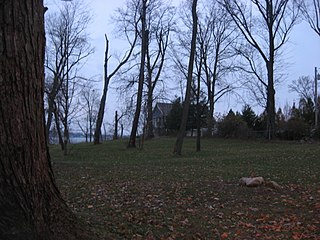
Woodbank, also known as Rasmussen Cottage, was a historic home located on Lake Maxinkuckee in Union Township, Marshall County, Indiana. It was a 2 1/2-story, Late Victorian style summer cottage built in 1894. It has been demolished.

Morningside Historic District is a national historic district located at Gary, Indiana. The district is characterized by spacious lots and tree-shaded curving streets. It encompasses 99 contributing buildings and 1 contributing site.
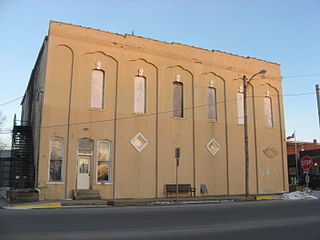
Silver Lake Historic District is a national historic district located at Silver Lake, Kosciusko County, Indiana. The district encompasses 19 contributing buildings in the central business district and surrounding residential section of Silver Lake. It developed between about 1865 and 1920, and includes notable examples of Italianate, Romanesque Revival, Classical Revival, and Early Commercial style architecture. Notable buildings include the former Enos Hotel, Municipal Building, and buildings on North Jefferson and East Main streets.
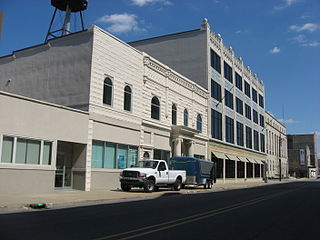
State Street Commercial Historic District is a national historic district located at Hammond, Lake County, Indiana. The district encompasses 28 contributing buildings in the central business district of Hammond. It developed between about 1885 and 1946, and includes notable example of Commercial, Classical Revival, Late Gothic Revival, and Art Deco style architecture. Notable buildings include the L. Fish Building (1927), Federal Building (1939), Lincoln Hotel (1923), Seifer Building (1925), and the Henderson Building (1902).

Hobart Commercial District is a national historic district located at Hobart, Lake County, Indiana. The district encompasses 38 contributing buildings in the central business district of Hobart. It developed between about 1869 and 1963, and includes notable example of Italianate, Classical Revival, and Art Deco style architecture. Notable buildings include the Verplank Building (1928), Orcutt Hotel and Office / Mander Building (1915), Fiester Building (1907), Fiester Building (1890-1893), Hobart Bank, Art Theater, Ben Ack Building (1926), Hobart Post Office, Roper Building / American Bank and Trust, First State Bank, Lake George Hotel / Stocker Building, Schultz Brothers Variety Store (1947), and the Kostbase Building (1950).
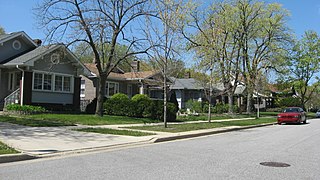
Forest–Moraine Residential Historic District is a national historic district located at Hammond, Lake County, Indiana. The district encompasses 108 contributing buildings in an exclusively residential section of Hammond. It developed between about 1913 and 1950, and includes notable example of Renaissance Revival, Colonial Revival, Tudor Revival, and English Cottage style residential architecture.
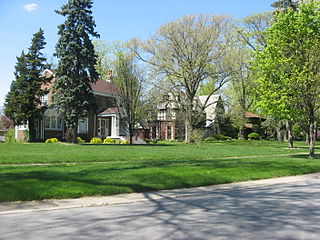
Forest–Southview Residential Historic District is a national historic district located at Hammond, Lake County, Indiana. The district encompasses 39 contributing buildings and 1 contributing site in an exclusively residential section of Hammond. It developed between about 1912 and 1949, and includes notable example of Renaissance Revival, Colonial Revival, Tudor Revival, and Bungalow / American Craftsman styles of residential architecture.

Hohman Avenue Commercial Historic District is a national historic district located at Hammond, Lake County, Indiana. The district encompasses 15 contributing buildings in the central business district of Hammond. It developed between about 1904 and 1956, and includes notable example of Romanesque Revival, Classical Revival, and Colonial Revival style architecture. Notable buildings include Knott's Apartments (1904), Emmerling Ambulance Garage (1918), Emmerling Building (1918), St. Joseph's Roman Catholic Church Complex, LaSalle Hotel, OK Building (1913), and the Hammond National Bank.

Washington Park is a historic public park and national historic district located on Lake Michigan at Michigan City, LaPorte County, Indiana. The park encompasses 13 contributing buildings, 3 contributing sites, 11 contributing structures, and 21 contributing objects, and includes the Michigan City Zoo. It was established in 1891 and later developed by the Works Progress Administration and its predecessors during the 1930s. Notable features include the Soldiers' and Sailors' Monument (1896), former park headquarters building (1934), bandstand (1911), World War I doughboy monument (1926), tennis court, log picnic shelter, and four-story observation tower (1936).
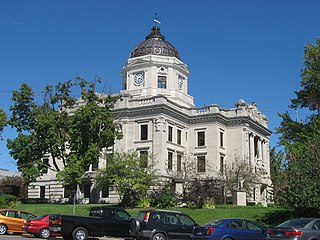
Courthouse Square Historic District is a national historic district located at Bloomington, Monroe County, Indiana. The district encompasses 57 contributing buildings in the central business district of Bloomington. It developed between about 1847 and 1936, and includes notable examples of Classical Revival, Beaux Arts and Italianate style architecture. Located in the district are the separately listed Bloomington City Hall, Monroe County Courthouse, Princess Theatre, and Wicks Building. Other notable buildings include the Federal Building, Masonic Temple, former Faulkner Hotel, Odd Fellows Building (1892), Allen Building (1907), First National Bank Building (1907), Knights of Pythias Building (1907), and Graham Hotel Building.

North Washington Street Historic District is a national historic district located in the city of Bloomington of Monroe County, Indiana. The district encompasses 35 contributing buildings and 6 contributing structures in a predominantly residential section of Bloomington. It developed between roughly 1870 and 1929, and includes notable examples of Queen Anne, Classical Revival, and Bungalow/American Craftsman style architecture. Located in the district is the separately listed Morgan House. Other notable buildings include the Showers-Graham House, Showers-Myers House, Teter House, and Washington Terrace Apartments (1929).

Ellettsville Downtown Historic District is a national historic district located at Ellettsville, Monroe County, Indiana. The district encompasses 50 contributing buildings in the central business district and surrounding residential sections of Ellettsville. It developed between about 1840 and 1953, and includes notable examples of Queen Anne, Early Commercial, Gothic Revival, and Bungalow/American Craftsman style architecture. Notable buildings include the Robert Stimson House, May Presley House, Bradford House, George W. Fletcher House, Wickens House (1909), Capt. Gilbert Perry House, I.O.O.F. Building, Town Hall (1927), Masonic Building (1895), Knights of Pythias Building, First United Methodist Church (1900), and First Baptist Church (1909).

East Washington Street Historic District is a national historic district located at Martinsville, Morgan County, Indiana. The district encompasses 64 contributing buildings, 1 contributing site, and 7 contributing structures in a predominantly residential section of Martinsville. It developed between about 1869 and 1940, and includes notable examples of Queen Anne, Classical Revival, and Colonial Revival style architecture. Located in the district is the separately listed Neely House. Other notable buildings include the Martinsville Presbyterian Church, Sweet House, Gum House, Hubbard-Gano House, Frank Oak Branch House (1916), and Francesconi House.

Fox Lake is a national historic district located in Pleasant Township, Steuben County, Indiana. The district encompasses 27 contributing buildings associated with the Fox Lake Resort vacation community. It developed between 1928 and 1950 as a vacation resort for middle class African-Americans. The cottages are primarily one-story, frame dwellings with gable roofs and concrete block foundations.

Perrin Historic District is a national historic district located at Lafayette, Tippecanoe County, Indiana. The district encompasses 173 contributing buildings and 2 contributing structures in a predominantly residential section of Lafayette. It developed between about 1869 and 1923 and includes representative examples of Italianate, Queen Anne, Colonial Revival, Stick Style / Eastlake Movement, and Bungalow / American Craftsman style architecture. Notable contributing buildings include the James Perrin House, John Heinmiller House, James H. Cable House, Adam Herzog House (1878), Coleman-Gude House (1875), Frank Bernhardt House (1873), August Fisher Cottage, John Beck House (1887), an William H. Sarles Bungalow (1923).
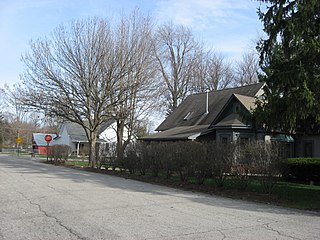
New Augusta Historic District is a national historic district located at Indianapolis, Indiana. It encompasses 114 contributing buildings, 1 contributing structure, and 1 contributing object in a railroad oriented village in Indianapolis. The district developed between about 1852 and 1939, and includes representative examples of Italianate and Bungalow / American Craftsman style architecture. Notable contributing buildings include the Odd Fellows Building, Hopewell Evangelical Lutheran Church, Salem Lutheran Church (1880), and New Augusta Depot. It is located west of Augusta.

Holy Rosary–Danish Church Historic District, also known as Fletcher Place II, is a national historic district located at Indianapolis, Indiana. The district encompasses 183 contributing buildings in a predominantly residential section located in the central business district of Indianapolis. It was developed between about 1875 and 1930, and include representative examples of Italianate, Gothic Revival, Tudor Revival, and Renaissance Revival style architecture. Located in the district is the separately listed Horace Mann Public School No. 13. Other notable buildings include the John Kring House, Trinity Danish Evangelical Lutheran Church (1872), John Wands House (1857), Henry Homburg House, Samuel Keely House, Maria Wuensch Cottage, and Holy Rosary Catholic Church (1911-1925).
